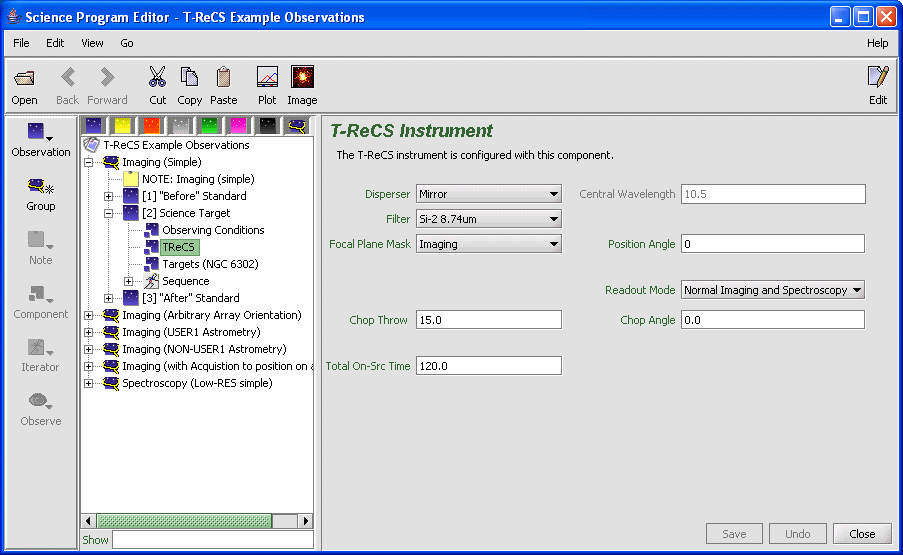
This page gives a basic discussion of T-ReCS imaging and spectroscopic observations as defined in the OT, which particular empahsis on the acquisition steps that are required for each type of observation. Such example observations are available in an OT library file that can be "fetched" from the Observing Tool database.
The following figures show how the T-ReCS component in the OT will look for (a) a simple imaging observation for a brighter target with the default position angles for chopping and for the detector array, and (b) an observation that needs to be taken with the specific position angle of 80 degrees. The way this last observation appears in the Position Editor is shown below.

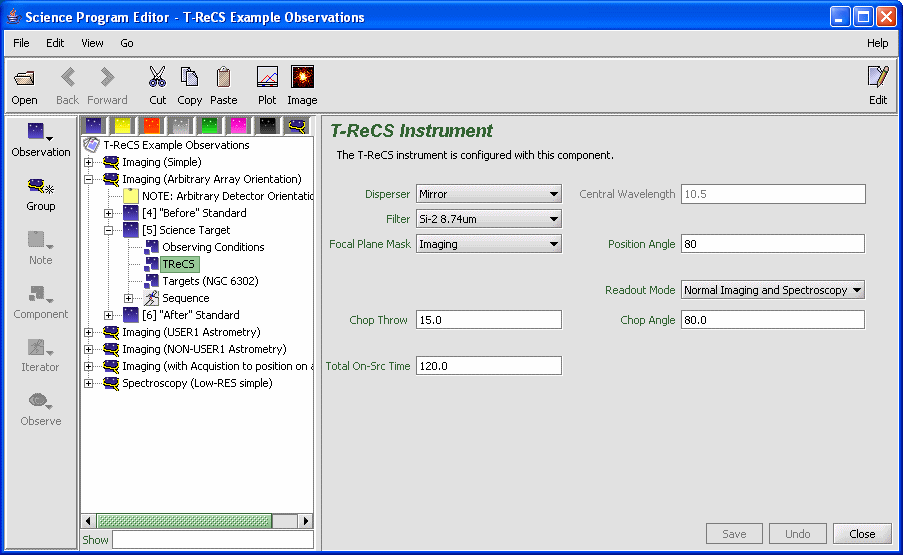
The values that most commonly need to be set are the "Filter" and the "Total On-Source Time". The latter corresponds to the usual idea of the exposure time. For a point source or for a small extended target, say less than 5 arc-seconds radius, one does not need to change the "Chop Angle" or the "Chop Throw", unless the source is bright (say more than 10 Jy) in which case it is better to change the "Chop Angle" to 45 degrees.
If one wants to have the "negative" beams on the detector, one can change the "Chop Throw" to a value of, say, 10 arc-seconds. One can also change the "Chop Angle" to 45 degrees. Since the telescope is not guiding in the off-source chop position, these negative images will not be suitable for combining with the "positive" image. If all one is interested in is aperture photometry one may be able to use the negative images but this should still be approached with some caution.
The following image shows the T-ReCS position window with the PWFS field of view shown. Here a catalogue search has been done to find a guide star, and a particular guide star has been chosen. The default should be to assign the guide star to PWFS2. We have made some test of T-ReCS usage with PWFS1 but most of our observations in semesters 2003B and onward have been made with PWFS2.
PWFS stars should have a radius between 5.0 and 6.5 arc-minutes of the target if at all possible (the best range is from 5.5 to 6.5 arc-minutes). Somewhat larger values up to about 6.8 arc-minutes and smaller values down to about 4.8 arc-minutes are possible. Guide stars with separations above 6.9 arc-minutes are too close to the edge of the PWFS field for proper corrections to be made. Below 4.7 arc-minutes the probes will start to shadow the detector. Note that the lower limit is specific to T-ReCS and it is different--typically larger--for other instruments.
As noted above, T-ReCS normally uses PWSF2 for the observations. It is possible to use PWFS1 if the guide star is brighter than magnitude roughly 12.5, and preferably somewhat brighter than 11.5. In our initial trials of using PWFS1 we observed a significant difference in the PSF when using PWFS1 rather than PWFS2, since PWFS1 generates corrections for trefoil as well as tip/tilt, whereas with PWFS2 only the tip/tilt corrections are done. Typically the PSF observed with PWFS2 has a significant trefoil component.
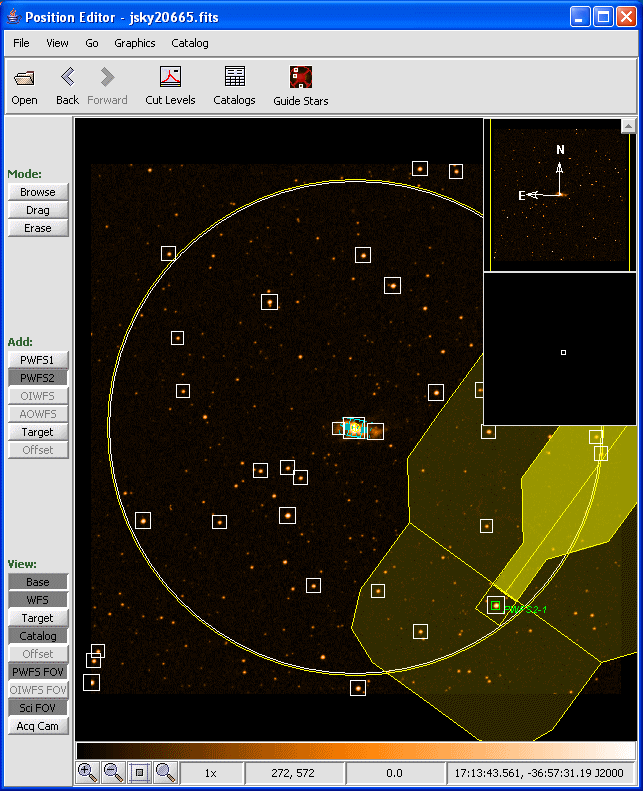
The next image shows the Position Editor view zoomed into the source region. This corresponds to the second imaging setup displayed above. The target, planetary nebula NGC 6302, has a bipolar axis just off of the east-west direction. The observation places the long axis of the T-ReCS detector along the central "waist" of the bipolar nebula, nearly in the north-south direction. The chopping is arranged to be along the bipolar axis, on the assumption that the mid-infrared emission peaks on the waist and is smaller along the lobes.
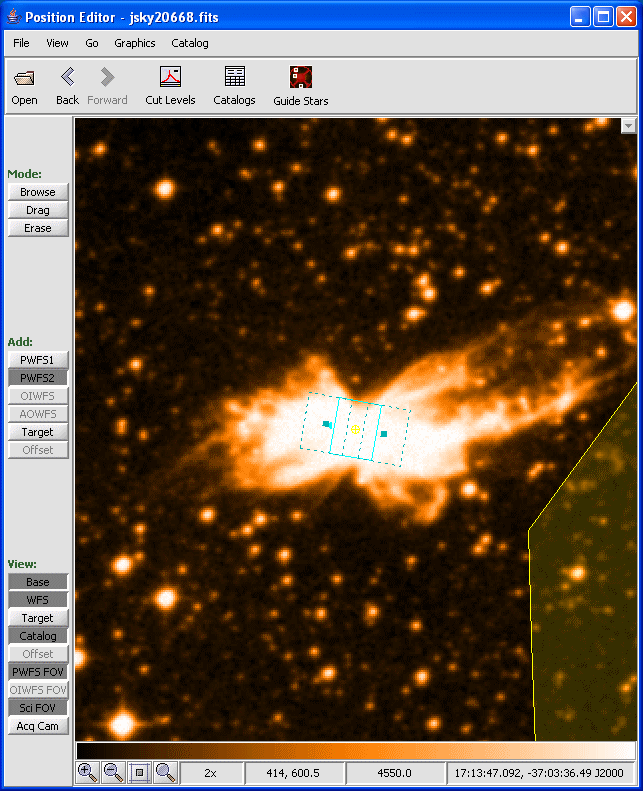
For a routine imaging observation the acquisition involves slewing to the target, acquiring the guide star, finding the target in the T-ReCS field of view, and waiting for the primary mirror tip/tilt corrections to be derived. Aside from making sure that proper guide stars have been selected, the only step in this process that involves T-ReCS is getting the object to the center of the field view.
In some cases, especially in observing standard stars which are point sources to T-ReCS, the astronomer carrying out the observations may chose to not bother moving the target to the array center. PIs can also skip the acquisition step if they so wish. This will save a small amount of setup time provided the object is found in the T-ReCS field of view. On the other hand it will cause a loss of time should the astronomer find that the target is poorly positioned.
To do imaging acquisition it is necessary to have an acquisition step defined. This must be a separate acquisition observation.
It is possible to skip the acquisition step for simple imaging observations if the target is a point source and if one does not care where the target ends up on the detector. Our experience from randomly selected standard stars and from queue observations without acquisition steps taken is that an object with a good position given in the OT file will appear somewhere in the central part of the T-ReCS field of view unless it has a significant proper motion, usually within a radius of 3 arc-seconds of the center of the field. This depends somewhat upon possible errors in the guide star position and the raw pointing accuracy of the telescope. If this is sufficient for the science program to be done, no acquisition step need be defined.
In the OT the acquisition step is a single observation that is done with the following parameters:
In the above the division between a "bright" source where "Chop" mode is used and a faint source where "Chop-Nod" mode is used is roughly 0.2 Jy in the N-band if using either the N filter or the Si filters, while the value would be higher when using the narrow-band filters. In the Q-band the brightness has to be of order 2 Jy because the sensitivity is about a factor of 10 worse than for the N filter. If observations have to be made at Qb the threshold is higher still by a factor of 2 or 3. These are conservative values. We can try on targets a bit fainter than this.
The following OT image shows an imaging observation with an initial acquisition step.
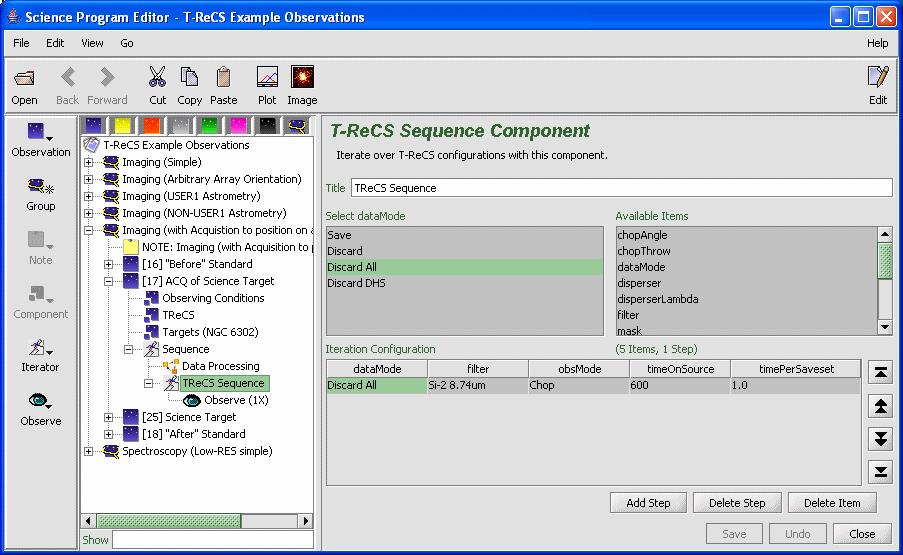
It is possible to peak up on a K-band, L-band, or M-band target and then take images in the N or Q windows. Due to the intrinsically poor detector sensitivity at wavelengths below 6 microns this is not normally going to do much good. For blind pointing one should pick an astrometric target as close to the source field as possible and carry out an astrometric observation to center this target, followed by slewing to the field. No T-ReCS acquisition step would be needed in that case, but the astrometric acquisition step would be charged to the program.
Astrometric "HOTSPOT" standards must have accurately known positions and be bright enough to be easily detected by T-ReCS in (say) the N-band filter. The nominal T-ReCS N-band sensitivity is magnitude 8.4 at S/N of 10 in 100 seconds. For a quick centering observation a star of N band magnitude 5 or brighter is required, and preferably of magnitude 4 or brighter. Normal K0-type stars have V-N colours of about 3 magnitudes, while normal G0-type stars have a V-N colour of about 1 magnitude. Thus any A0-type star of magnitude 4 or brighter, G0-type star of magnitude 5 or brighter, or K0-type star of magnitude 7 or brighter is likely to be suitable for astrometric observations by T-ReCS. For more information see T-ReCS Astrometry.
When spectroscopy is carried out the setup is somewhat different than that for imaging. A single step spectroscopic observation in the N-band would have a T-ReCS main component set-up similar to the following:
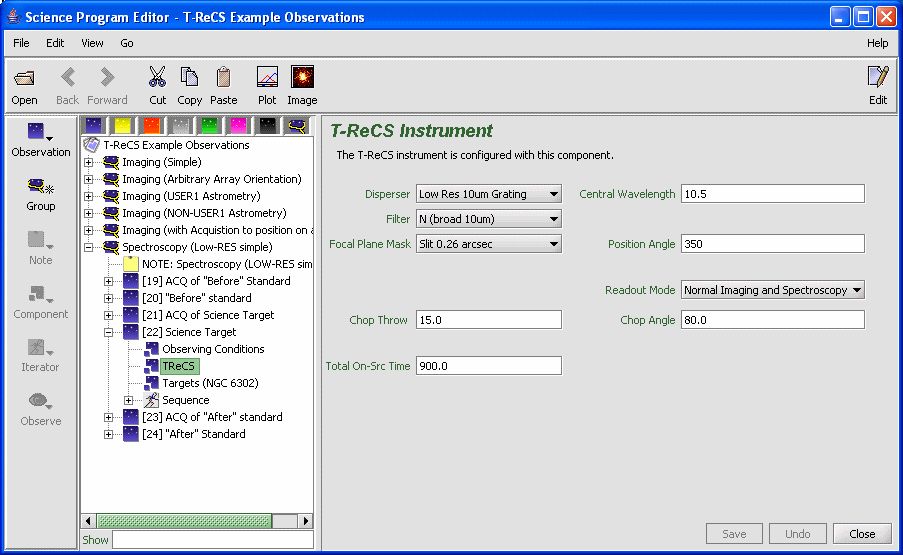
Items to note are the choice of the Disperser, the Focal Plane Mask, the filter (almost always N-band for LowRes10 or HighRes10 observations, and almost always Q-band for LowRes20 observations, although in rare circumstances a different filter might be chosen), and the Chop Angle. For a point source one might wish to chop along the slit. It is also possible to chop less than 15 arc-seconds along the slit and thus have the two "negative" spectra in the frame, although it is not clear how to use these negative spectra since the observation is unguided in the off-source beam. For an extended source one would normally chop perpendicular to the slit so that one is not chopping the source spectrum onto itself.
The next image shows how the spectral set-up of an extended target would normally look in the Position Editor. The slit is positioned along the waist of NGC 6302, and chopping is done at right angles from the slit direction.
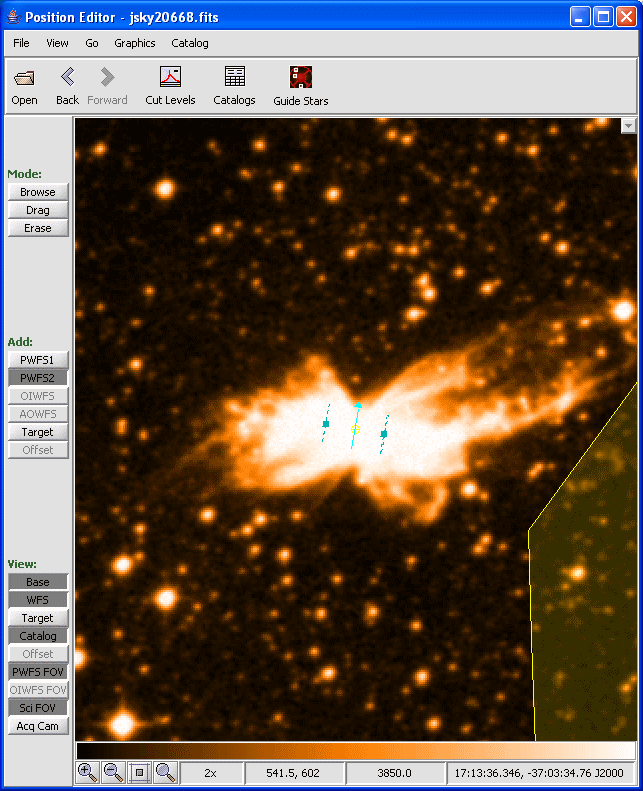
For spectroscopy observations the acquisition steps are required for each observation: each wavelength range and each slit position angle. In each case the target has to be re-centered on the slit. For long spectral observations periodic re-centering may be needed as well. Each such acquisition takes of order 15 minutes overhead, and the very first spectroscopic acquisition requires an additional 15 minutes overhead to slew to the object, acquire the guide star, and so on.
The image below shows how the main T-ReCS sequencer is set for a spectroscopic acquisition of a brighter target. It consists of four steps:
The first step does not take long and is aborted once the slit position on the detector has been marked. No data is saved from this step. The second step is analogous to the imaging acquisition step, an exposure to allow the operator to offset the telescope as required to move the target to the proper position. This step also is aborted once the target is in position and no image is saved.
The next two steps are to take images that are saved for the PI, so the PI will know where the slit is positioned. First an image of the field is taken and saved. How long this needs to be depends on how bright any source in the field is. Then the slit is put in again and an image of the field through the slit is taken.
If the target of the spectroscopy observation is invisible in the N-band or the Q-band then spectroscopy is probably impractical. In principle we can peak up on a source in the K, L or M filters and proceed with spectroscopy from there. In practise due to the poor quantum efficiency of the T-ReCS detector at shorter wavelengths this is unlikely to work.
If one wishes to locate the slit on something that is best detected in a filter other than the N-band filter or the Q-band filter (whichever is appropriate for the spectroscopy) then the offsets caused by changing filter must be allowed for. This can be done but is more difficult than an N-band setup, and there is likely to be a larger overhead in setting up the observation. The filter to filter offsets can be measured using a star. For the moment, since we have no data about whether these shifts depend on the telescope elevation, we strongly suggest that such observations be done if this type of setup is needed. All such cases should be discussed with the contact scientist.
Last update March 13, 2006; James Radomski